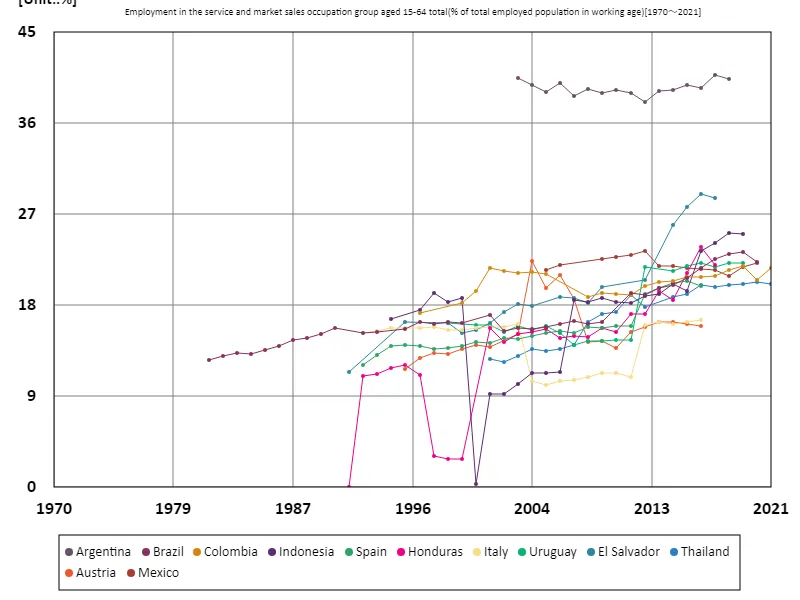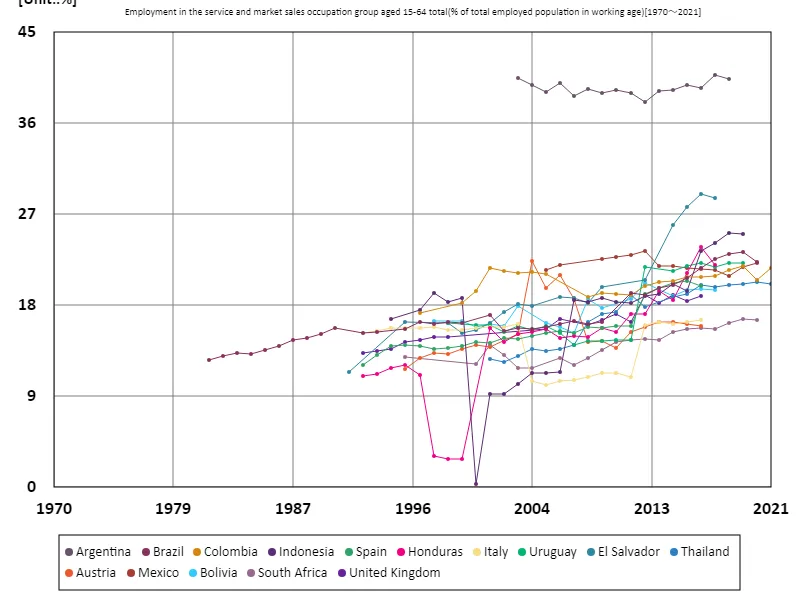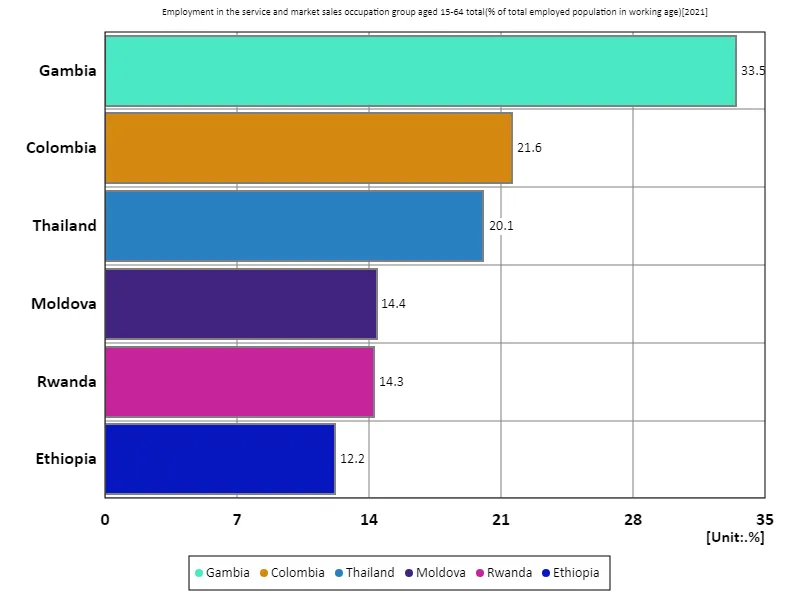- Abstract
- Employment rates for all 15-64 year olds, service and marketing sectors (percentage of working-age population)
- Employment rates for all 15-64 year olds, service and marketing sectors (percentage of working-age population) (Worldwide)
- Employment rates for 15-64 year olds overall, service and marketing sectors (percentage of working age employed) (worldwide, latest year)
- Reference
Abstract
Colombia’s 2021 data is notable for having the highest employment rate for all 15-64 year-olds in the service and market sales sector, at 21.6%. This suggests that Colombia’s economy is dependent on the service sector. Given historical trends, the expansion of the service sector has been a contributing factor to economic growth in many Latin American countries. Colombia is no exception, with the service and marketing sectors growing in importance as the economy diversifies and urbanizes. Rising consumer demand, especially in urban areas, is likely driving employment rates in these sectors. Additionally, the influence of economic policies and international investment may also contribute to the growth of the services sector.
Employment rates for all 15-64 year olds, service and marketing sectors (percentage of working-age population)
Across the data from 1981 to 2021, there are notable changes in employment rates in the service and market sales sectors for working-age people aged 15-64. Argentina’s 40.7% figure in 2017 is very high by global standards and reflects the country’s heavy reliance on the service sector. The decline in employment from its peak to the current rate of 99.2% likely reflects changing economic conditions and structural shifts. Argentina’s fluctuations suggest the nature of the service industry, which is vulnerable to economic fluctuations and policies. Over the past few decades, employment rates in the service and marketing sectors have generally been on the rise in many countries. The main factors behind this are the progress of globalization and urbanization, as well as changes in industrial structure due to technological innovation. However, there are also cases, such as Argentina, where employment rates have fallen significantly from their peak, due to economic downturns, policy changes, or external shocks. Overall, the importance of the service sector is increasing, but fluctuations in employment rates in the service sector depend heavily on the economic background and policies of each country.


The maximum is 40.7%[2017] of Argentina, and the current value is about 99.2%
Employment rates for all 15-64 year olds, service and marketing sectors (percentage of working-age population) (Worldwide)
Looking at data from 1981 to 2021, employment rates in the service and market sales sectors for the 15-64 age group have been increasing globally. In particular, Argentina’s 40.7% growth in 2017 indicates significant growth in the services sector. This figure reflects a period when Argentina’s economy was heavily reliant on services, but the current employment rate, down to 99.2% from its peak, may reflect economic fluctuations and structural challenges. The trend over the past few decades has been a general increase in employment in the service sector. This is due to the shift from manufacturing to the service sector amidst increasing globalization, technological innovation, and urbanization. However, there are also cases such as Argentina where there has been a marked decline from the peak, suggesting the impact of economic crises, policy changes and international factors. Overall, service industry employment continues to grow, but fluctuations are strongly influenced by national economic conditions and policies.


The maximum is 40.7%[2017] of Argentina, and the current value is about 99.2%
Employment rates for 15-64 year olds overall, service and marketing sectors (percentage of working age employed) (worldwide, latest year)
Based on 2021 data, The Gambia has the highest employment rate in the services and market sales sector among the working age group 15-64 years at 33.5%, while the average is 19.3%. The total of 116% also suggests that some workers may work in more than one sector. Historically, employment rates in the service sector have generally been rising, with many countries becoming more reliant on the service sector. This is due to a shift from manufacturing to services amid globalization, technological advances and urbanization. The Gambia’s high employment rate reflects the country’s economic structure and industrial characteristics, which indicate a relatively high demand for services. However, the average value of 19.3% also shows that there are large country differences in employment rates in the service and market sales sectors. The total figure of 116% reflects the diversity of the labor market and the phenomenon of workers having multiple jobs, and illustrates the differences in economic situations and employment environments between countries.


The maximum is 33.5% of Gambia, the average is 19.3%, and the total is 116%


Comments